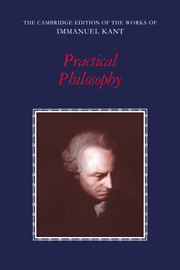Book contents
- Frontmatter
- Contents
- General editors' preface
- Preface
- General introduction
- Review of Schulz's Attempt at an introduction to a doctrine of morals for all human beings regardless of different religions (1783)
- An answer to the question: What is enlightenment? (1784)
- On the wrongfulness of unauthorized publication of books (1785)
- Groundwork of The metaphysics of morals (1785)
- Review of Gottlieb Hufeland's Essay on the principle of natural right (1786) [translated and edited by Allen Wood]
- Kraus's review of Ulrich's Eleutheriology (1788)
- Critique of practical reason (1788)
- On the common saying: That may be correct in theory, but it is of no use in practice (1793)
- Toward perpetual peace (1795)
- The metaphysics of morals (1797)
- On a supposed right to lie from philanthropy (1797)
- On turning out books (1798) [translated and edited by Allen Wood]
- Editorial notes
- Glossary
- Index of names
- Index of subjects
Toward perpetual peace (1795)
Published online by Cambridge University Press: 05 June 2012
- Frontmatter
- Contents
- General editors' preface
- Preface
- General introduction
- Review of Schulz's Attempt at an introduction to a doctrine of morals for all human beings regardless of different religions (1783)
- An answer to the question: What is enlightenment? (1784)
- On the wrongfulness of unauthorized publication of books (1785)
- Groundwork of The metaphysics of morals (1785)
- Review of Gottlieb Hufeland's Essay on the principle of natural right (1786) [translated and edited by Allen Wood]
- Kraus's review of Ulrich's Eleutheriology (1788)
- Critique of practical reason (1788)
- On the common saying: That may be correct in theory, but it is of no use in practice (1793)
- Toward perpetual peace (1795)
- The metaphysics of morals (1797)
- On a supposed right to lie from philanthropy (1797)
- On turning out books (1798) [translated and edited by Allen Wood]
- Editorial notes
- Glossary
- Index of names
- Index of subjects
Summary
Introduction
In 1795 King Frederick William II of Prussia withdrew from the War of the First Coalition and, on April 5, concluded the separate Peace of Basel with the revolutionary government of France. In a letter of August 15 of the same year (12: 35) Kant offered the Königsberg publisher Nicolovius what may well be the most widely read of his informal works, Toward Perpetual Peace.
Projects for “perpetual peace,” and criticisms of them, had been in the air since 1713, when the Abbé St. Pierre, a secretary at the congress preceding the Treaty of Utrecht, had published the first two volumes of his Projet pour rendre la paix perpetuelle en Europe. Among the more prominent of his defenders and critics were Leibniz, Voltaire, Frederick the Great, and Rousseau. As might be expected, Kant was aware of the debate. In a Reflection that Adickes dates from about 1755 Kant notes Bayle's view that, although “it is possible in abstracto to put the rules of Christianity into practice, this is not the case with regard to princes: it was impossible in connection with the Abbé St. Pierre's proposal” (6: 241; AK 16, #2116). As the present essay shows, Kant did not consider the idea of a league of nations impossible, but he did not rely for his evidence upon experience of how princes have behaved.
- Type
- Chapter
- Information
- Practical Philosophy , pp. 311 - 352Publisher: Cambridge University PressPrint publication year: 1996
- 51
- Cited by



